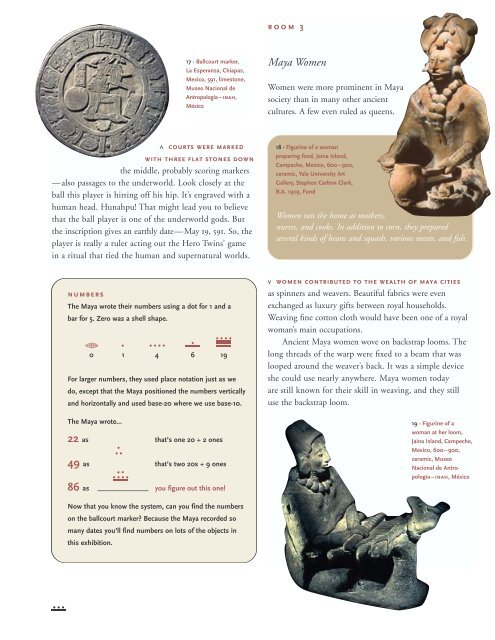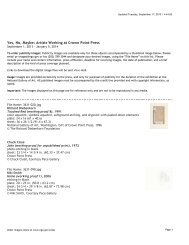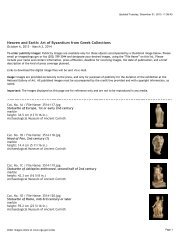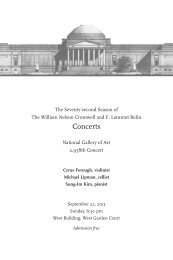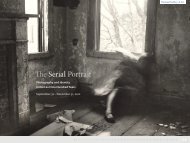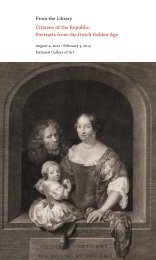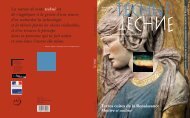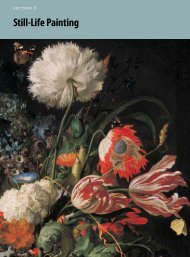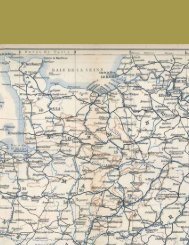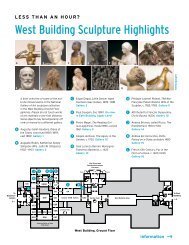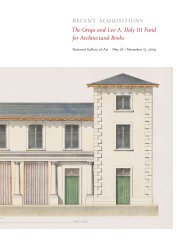Courtly Art of the Ancient Maya - National Gallery of Art
Courtly Art of the Ancient Maya - National Gallery of Art
Courtly Art of the Ancient Maya - National Gallery of Art
You also want an ePaper? Increase the reach of your titles
YUMPU automatically turns print PDFs into web optimized ePapers that Google loves.
^ courts were marked<br />
with three flat stones down<br />
<strong>the</strong> middle, probably scoring markers<br />
—also passages to <strong>the</strong> underworld. Look closely at <strong>the</strong><br />
ball this player is hitting <strong>of</strong>f his hip. It’s engraved with a<br />
human head. Hunahpu! That might lead you to believe<br />
that <strong>the</strong> ball player is one <strong>of</strong> <strong>the</strong> underworld gods. But<br />
<strong>the</strong> inscription gives an earthly date—May 19, 591. So, <strong>the</strong><br />
player is really a ruler acting out <strong>the</strong> Hero Twins’ game<br />
in a ritual that tied <strong>the</strong> human and supernatural worlds.<br />
numbers<br />
17 · Ballcourt marker,<br />
La Esperanza, Chiapas,<br />
Mexico, 591, limestone,<br />
Museo Nacional de<br />
Antropología–inah,<br />
México<br />
The <strong>Maya</strong> wrote <strong>the</strong>ir numbers using a dot for 1 and a<br />
bar for 5. Zero was a shell shape.<br />
0 1 4 6 19<br />
For larger numbers, <strong>the</strong>y used place notation just as we<br />
do, except that <strong>the</strong> <strong>Maya</strong> positioned <strong>the</strong> numbers vertically<br />
and horizontally and used base-20 where we use base-10.<br />
The <strong>Maya</strong> wrote…<br />
22 as that’s one 20 + 2 ones<br />
49 as that’s two 20s + 9 ones<br />
86 as ______________ you figure out this one!<br />
Now that you know <strong>the</strong> system, can you find <strong>the</strong> numbers<br />
on <strong>the</strong> ballcourt marker? Because <strong>the</strong> <strong>Maya</strong> recorded so<br />
many dates you’ll find numbers on lots <strong>of</strong> <strong>the</strong> objects in<br />
this exhibition.<br />
room 3<br />
<strong>Maya</strong> Women<br />
Women were more prominent in <strong>Maya</strong><br />
society than in many o<strong>the</strong>r ancient<br />
cultures. A few even ruled as queens.<br />
18 · Figurine <strong>of</strong> a woman<br />
preparing food, Jaina Island,<br />
Campeche, Mexico, 600–900,<br />
ceramic, Yale University <strong>Art</strong><br />
<strong>Gallery</strong>, Stephen Carlton Clark,<br />
B.A. 1903, Fund<br />
Women ran <strong>the</strong> home as mo<strong>the</strong>rs,<br />
nurses, and cooks. In addition to corn, <strong>the</strong>y prepared<br />
several kinds <strong>of</strong> beans and squash, various meats, and fish.<br />
v women contributed to <strong>the</strong> wealth <strong>of</strong> maya cities<br />
as spinners and weavers. Beautiful fabrics were even<br />
exchanged as luxury gifts between royal households.<br />
Weaving fine cotton cloth would have been one <strong>of</strong> a royal<br />
woman’s main occupations.<br />
<strong>Ancient</strong> <strong>Maya</strong> women wove on backstrap looms. The<br />
long threads <strong>of</strong> <strong>the</strong> warp were fixed to a beam that was<br />
looped around <strong>the</strong> weaver’s back. It was a simple device<br />
she could use nearly anywhere. <strong>Maya</strong> women today<br />
are still known for <strong>the</strong>ir skill in weaving, and <strong>the</strong>y still<br />
use <strong>the</strong> backstrap loom.<br />
19 · Figurine <strong>of</strong> a<br />
woman at her loom,<br />
Jaina Island, Campeche,<br />
Mexico, 600–900,<br />
ceramic, Museo<br />
Nacional de Antropología–inah,<br />
México


